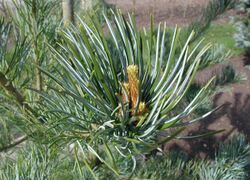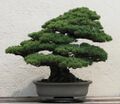Biology:Pinus parviflora
| Pinus parviflora | |
|---|---|

| |
| Scientific classification | |
| Kingdom: | Plantae |
| Clade: | Tracheophytes |
| Clade: | Gymnospermae |
| Division: | Pinophyta |
| Class: | Pinopsida |
| Order: | Pinales |
| Family: | Pinaceae |
| Genus: | Pinus |
| Subgenus: | P. subg. Strobus |
| Section: | P. sect. Quinquefoliae |
| Subsection: | P. subsect. Strobus |
| Species: | P. parviflora
|
| Binomial name | |
| Pinus parviflora Siebold & Zucc.
| |
Pinus parviflora, also known as five-needle pine,[2] or Japanese white pine,[2] is a pine in the white pine group, Pinus subgenus Strobus, native to Japan.
It is a coniferous evergreen tree, growing to 15–25 m in height and is usually as broad as it is tall, forming a wide, dense, conical crown. The leaves are needle-like, in bundles of five, with a length of 5–6 cm. The cones are 4–7 cm long, with broad, rounded scales; the seeds are 8–11 mm long, with a vestigial 2–10 mm wing.[citation needed]
The Latin specific epithet parviflora means "with small flowers".[3]
This is a popular tree for bonsai, and is also grown as an ornamental tree in parks and gardens. The cultivars 'Adcock's Dwarf' and 'Bonnie Bergman'[4] have gained the Royal Horticultural Society's Award of Garden Merit.[5][6]
Gallery
References
- ↑ Farjon, A. (2013). "Pinus parviflora". IUCN Red List of Threatened Species 2013: e.T42388A2977007. doi:10.2305/IUCN.UK.2013-1.RLTS.T42388A2977007.en. https://www.iucnredlist.org/species/42388/2977007. Retrieved 11 November 2021.
- ↑ 2.0 2.1 "Pinus parviflora Siebold & Zucc.". United States Department of Agriculture. http://plants.usda.gov/core/profile?symbol=PIPA12.
- ↑ Harrison, Lorraine (2012). RHS Latin for Gardeners. United Kingdom: Mitchell Beazley. ISBN 978-1845337315.
- ↑ "RHS Plantfinder - Pinus parviflora 'Bonnie Bergman'". https://www.rhs.org.uk/Plants/67902/i-Pinus-parviflora-i-Bonnie-Bergman/Details.
- ↑ "RHS Plant Selector – Pinus parviflora 'Adcock's Dwarf'". https://www.rhs.org.uk/Plants/77345/Pinus-parviflora-Adcock-s-Dwarf/Details.
- ↑ "AGM Plants - Ornamental". Royal Horticultural Society. July 2017. p. 78. https://www.rhs.org.uk/plants/pdfs/agm-lists/agm-ornamentals.pdf.
Wikidata ☰ Q178116 entry
 |





